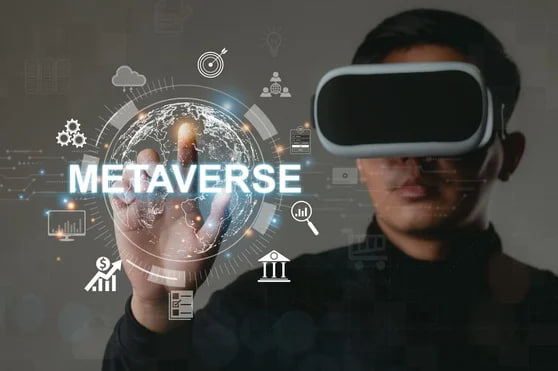The metaverse isn't just a buzzword - it's the next frontier for leadership. As digital transformation accelerates, the metaverse is reshaping leadership.
Metaverse leadership is no longer optional—it’s a strategic necessity. In this rapidly evolving digital arena, leaders must learn to navigate immersive environments, build trust without physical presence, and make faster, more informed decisions.
So how can leaders unlock the full potential of this new transformation?
Read on to explore the opportunities—and the challenges—that await leaders shaping their future in the expanding metaverse.
Defining the Metaverse—and why it matters for leaders
The metaverse is a three-dimensional digital realm powered by virtual reality, augmented reality, and artificial intelligence. Users interact via avatars that represent their digital identities, creating immersive experiences that enhance collaboration, creativity, and human connection.
Why the metaverse matters for leadership?
Across education, business, commerce, healthcare, gaming, and entertainment—and increasingly, leadership—the metaverse is transforming how people learn, work, and engage. For leaders, it represents a profound shift in team management and culture in a distributed world.
The metaverse facilitates seamless and effective virtual team management, allowing leaders to create immersive digital workspaces where dispersed teams can collaborate seamlessly.
Nth Floor serves as a virtual twin of its headquarters. New hires from around the globe meet there for onboarding, training, and social connection, reducing the friction of distance and strengthening their sense of belonging from day one.
The metaverse’s core leadership advantages
The metaverse introduces a set of powerful benefits that are revolutionizing modern leadership and equipping leaders to operate with greater agility and creativity. Here are the most significant advantages:
- Immersive leadership training: The metaverse provides immersive simulations of complex, real-world scenarios—such as crisis management, high-stakes decision-making, and organizational change—within a safe and controlled environment. Leaders can practice and refine their skills in a risk-free space.
- Tailored, interactive learning programs: Leaders can deliver personalized training experiences inside dynamic virtual environments. These programs adapt to team needs, elevate workforce capability, and prepare employees to navigate future challenges with confidence and competence.
- Accelerated innovation and new business models: The metaverse empowers leaders to experiment with innovative strategies, explore next-generation business models, and prototype products and services within interactive 3D environments. It also opens new avenues for customer and stakeholder engagement through immersive previews and virtual interactions.
- Stronger collaboration and communication: With shared virtual spaces, teams can collaborate more naturally—even when dispersed across continents. These environments strengthen alignment, streamline decision-making, and reduce the friction of remote work.
- A wider talent pool and greater inclusion: The metaverse enables effortless global collaboration. Leaders can access diverse talent, involve experts from anywhere, and build more inclusive teams. This expanded reach not only enriches organizational culture but also unlocks new growth opportunities.

How metaverse leadership differs from traditional leadership?
Leadership in the metaverse diverges sharply from conventional models. The table below highlights the core distinctions in structure, communication, oversight, and adaptability:
|
Dimension |
Traditional leadership |
Metaverse leadership |
|
Structure & authority |
Rigid hierarchies, concentrated authority, and limited employee involvement in decision-making. |
Fluid, instantly connected environments with distributed teams and tools that strengthen collaboration. |
|
Communication style |
In-person meetings, slower communication cycles, and less efficiency in today’s digital landscape. |
Real-time interaction inside immersive virtual spaces, enabling faster alignment and more collaborative decisions. |
|
Oversight & supervision |
Direct, physical supervision with tight control over performance—often at the cost of innovation. |
Remote team management supported by advanced simulations, continuous data insights, and real-time performance analytics. |
|
Adaptability & innovation |
Slower to adapt, reliant on legacy experience, and vulnerable to rapid change. |
Highly flexible environments that empower leaders to act quickly, test ideas, and make informed, future-focused decisions. |
Opportunities and challenges for leaders in the metaverse
While the metaverse unlocks remarkable possibilities, it also introduces complex challenges that require a new level of digital fluency and adaptive leadership. Below are the key opportunities reshaping leadership in this emerging space:
- Global collaboration at scale: The metaverse enables leaders to build globally distributed teams that operate inside shared, immersive environments—driving diversity, creativity, and cohesion. Meta, for instance, brings its engineering and marketing teams together from around the world in a single virtual meeting room to align on complex projects.
- Creating new job opportunities: As work becomes increasingly digital, the metaverse is spawning entirely new career paths—roles like Metaverse Experience Engineer and Virtual World Designer. This shift opens the door to more flexible work models and a broader talent ecosystem.
- Accelerated innovation and creative engagement: Leaders can leverage VR, AR, and AI to cultivate innovation within virtual spaces. These environments allow teams to test ideas, iterate rapidly, and co-create solutions.
- Enhanced customer experiences: The metaverse gives organizations new channels for deep, interactive engagement. Brands like Nike and Gucci have already launched virtual stores where customers browse, customize, and interact with digital products—redefining loyalty and brand relationship.
- Advanced digital skill building: Leaders can leverage the metaverse to rapidly upskill teams, equipping employees with the digital capabilities necessary to keep pace with technological change and future-proof the organization.
Key challenges leaders face when training in the metaverse
Despite its promise, metaverse-based training presents several leadership challenges that necessitate an intentional strategy and digital maturity. The most significant include:
- Building trust without physical presence: Establishing trust in virtual environments is challenging when leaders can’t rely on in-person cues, such as body language or eye contact. Creating psychological safety requires more deliberate transparency, consistent communication, and thoughtful relationship-building across avatars and screens.
- Sustaining organizational culture: In the metaverse, culture doesn’t emerge organically. Without real-world interactions, it becomes increasingly challenging to reinforce shared values, strengthen team cohesion, and foster a sense of belonging.
- Balancing innovation with privacy: Effective digital leadership means embracing advanced tools while safeguarding employee and organizational data. Leaders must establish clear data-governance standards and ensure that innovation never compromises confidentiality or trust.
- Adapting to new digital tools: Shifting to the metaverse demands new technical capabilities from both leaders and employees. This can create initial resistance or skill gaps. Overcoming such obstacles requires consistent investment in digital upskilling.
Effective leadership strategies for the metaverse
Leading in the metaverse requires fresh strategies tailored to immersive environments and digitally driven interactions. The following approaches help leaders strengthen engagement, performance, and cohesion inside virtual worlds:
1. Build trust and improve connections in virtual teams
Trust and effective communication are essential in virtual workplaces. Leaders can reinforce connection through:
- Open communication: Host brief daily check-ins or virtual office hours inside metaverse platforms to maintain a steady rhythm of interaction.
- Radical transparency: Share decisions, updates, and context openly in shared digital spaces.
- Personal connection through avatars: Encourage informal social moments—such as virtual lounges, team hangouts, or avatar-driven activities—to humanize relationships.
- Technology-enabled collaboration: Use immersive tools to co-create documents, manage projects, and visualize progress in real time.
- Continuous recognition: Celebrate milestones and acknowledge contributions inside virtual environments to boost morale and sustain momentum.
2. Motivating and engaging employees in immersive digital environments
Sustaining motivation in immersive digital spaces requires intentional design and active engagement. Leaders can foster a high-energy culture through the following practices:
- Create engaging, interactive workspaces: Design virtual environments that spark curiosity and foster
- Use digital rewards to reinforce motivation: Offer symbolic incentives or metaverse-based digital assets to recognize effort and celebrate achievements.
- Involve employees in decision-making: Leverage virtual voting tools, breakout rooms, or metaverse workshops to gather input.
- Strengthen social connection: Host virtual coffee breaks, informal meetups, or social events across metaverse platforms.
- Provide ongoing training on digital tools: Ensure every team member feels confident navigating metaverse platforms.
3. Driving collaboration and innovation in shared virtual spaces
Seamless collaboration and continuous innovation drive success in virtual teams. Leaders can elevate both by intentionally designing environments that ignite creativity and streamline collective work:
- Build stimulating digital work environments: Equip teams with virtual design tools, prototyping spaces, and immersive environments where ideas can be tested.
- Cultivate innovation: Encourage virtual brainstorming sessions and challenge legacy assumptions.
- Enable seamless teamwork through technology: Use metaverse platforms that support synchronous collaboration on documents, whiteboards, and 3D models.
- Energize teams with social and professional interaction: Host virtual hackathons, innovation sprints, or metaverse-based competitions to spark creativity and strengthen cross-team engagement.
- Build innovation and collaboration skills: Offer targeted training inside the metaverse on co-creation methods.

Essential leadership skills for the metaverse era
Digital leadership skills are critical for navigating immersive, rapidly evolving virtual environments. Key competencies for metaverse leaders include:
1. Digital intelligence and emerging technology literacy
Leaders must understand and effectively leverage technologies such as AI, virtual reality, and blockchain to guide their teams and make informed decisions. High digital intelligence enables leaders to spot opportunities—such as using blockchain to enhance supply chain transparency within the metaverse.
2. Adaptability and agility in dynamic virtual environments
As digital landscapes evolve, leaders must respond swiftly by adjusting their strategies to capitalize on emerging opportunities. Flexible leaders pivot away from legacy methods, continuously aligning their approach with the demands of immersive, changing virtual workspaces.
3. Ethical leadership and digital responsibility
Ethical metaverse leadership combines transparency, integrity, and adherence to organizational values with a rigorous approach to digital responsibility. Protecting data, fostering trust, and ensuring fair use of technology are paramount. In a world where privacy and security challenges are amplified, ethical leaders become the cornerstone of safe and trustworthy digital environments.
Conclusion
The metaverse represents a transformative shift in leadership, equipping leaders with advanced digital tools to enhance communication, drive innovation, and manage teams effectively within immersive virtual spaces. Yet, this digital frontier also presents challenges that demand new skills—building trust, safeguarding privacy, and developing team digital capabilities.
Leaders who embrace these challenges and invest in their digital growth will distinguish themselves, guiding their organizations toward sustainable success in the metaverse era.
Mastering the principles of metaverse leadership will determine who emerges as a true leader in this exciting, evolving realm. Start cultivating your digital leadership skills today and join the ranks of those shaping the future in the metaverse.
This article was prepared by trainer Husien Habib Al Sayed, certified coach from Wolfa Academy.






